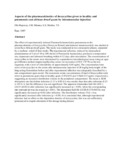Aspects of the pharmacokinetics of doxycycline given to healthy and pneumonic east african dwarf goats by intramuscular injection

View/
Date
1997Author
Ole-Mapenay, I.M
Mitema, E.S
Maitho, T.E
Type
ArticleLanguage
enMetadata
Show full item recordAbstract
The effect of experimentally induced Pasteurella haemolytica pneumonia on the pharmacokinetics of doxycycline (Doxycen Retard) administered intramuscularly was studied in seven East African dwarf goats. The study was conducted in two consecutive phases, separated by a washout ~eriod of four weeks. The experimental infection, induced by intratracheal administration of 5 ml of 10 to 109 cfu/ml of Pasteurella haemolytica, produced a temperature rise, depression and laboured breathing within 6-12 days after inoculation.
The concentrations of doxycycline in the serum were determined by a quantitative microbiological assay using an agar-gel diffusion method employing Bacillus cereus var mycoides (ATCC 11778) as the test organism, with a level of detectability of approximately 0.05 ug/ml. The concentration-time curve of doxycycline in the serum after intramuscular injection of 20 mg/kg bodyweight of the long-acting formulation before and after experimental infection was adequately described by a one-compartment open model.
The maximum serum concentrations (CmaJ of doxycycline were lower in pneumonic goats than in healthy goats (3.87±0.52 and 5.56±0.213 ug/ml, respectively), suggesting an increased distribution volume in the peripheral compartment. The mean ± SEM absorption rate (ka) before infection (1.13 ± 0.02 h-l) was smaller than that after infection (8.23 ± 3.81 h-l), but the difference was not significant. The apparent elimination half-life (tI/2~) (24.51 ±0.02 h) after infection was significantly increased (p < 0.05), while the corresponding rate constant (p) was decreased (p < 0.01). The absorption half-life (t1/2J (0.137±0.03 h) was significantly decreased (p<0.01) after infection. The distribution volume (Vd(~) was significantly increased after infection (p < 0.05). It is concluded that, although experimental infection had an effect on the disposition kinetics of doxycycline, this was not sufficiently pronounced to require alteration of the dosage during disease
Citation
Veterinary Research Communications, 21 (1997) 453-462Publisher
Department of Public Health, Pharmacology and Toxicology, Faculty of Veterinary
